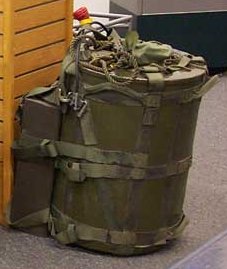
Back স্যুটকেস পরমাণু অস্ত্র Bengali/Bangla Kofferatombombe German Dispositivo nuclear de maleta Spanish Bomba atomica da zaino Italian 핵배낭 Korean Draagbare atoombom Dutch Walizkowa bomba jądrowa Polish Валізний ядерний пристрій Ukrainian

A suitcase nuclear device (also suitcase nuke, suitcase bomb, backpack nuke, snuke, mini-nuke, and pocket nuke) is a tactical nuclear weapon that is portable enough that it could use a suitcase as its delivery method.
Both the United States and the Soviet Union developed nuclear weapons small enough to be portable in specially-designed backpacks during the 1950s and 1960s.[1][2]
Neither the United States nor the Soviet Union have ever made public the existence or development of weapons small enough to fit into a normal-sized suitcase or briefcase.[3] The W48 however, does fit the criteria of small, easily disguised, and portable. Its explosive yield was extremely small for a nuclear weapon.[4][5]
In the mid-1970s, debate shifted from the possibility of developing such a device for the military to concerns over its possible use in nuclear terrorism.[6] The concept became a staple of the spy thriller genre in the later Cold War era.[7]
- ^ Woolf, Amy F (August 10, 2009), Nonstrategic Nuclear Weapons (PDF), FAS, archived (PDF) from the original on May 25, 2006, retrieved June 4, 2016
- ^ Shrader, K. "Suitcase nukes closer to fiction than reality". ABC News. Archived from the original on 2018-09-20. Retrieved 2009-08-11.
- ^ Sublette, Carey (2002). "Are Suitcase Bombs Possible?". Nuclear Weapon Archive.
- ^ "Complete List of All U.S. Nuclear Weapons". Nuclear Weapon Archive.
- ^ Gsponer, Andre (15 October 2018). "The B61-based 'Robust Nuclear Earth Penetrator': Clever retrofit or headway towards fourth-generation nuclear weapons?". arXiv:physics/0510052v1.
- ^ "Preventing Suitcase Warfare: Loren Eiseley, the great University of Pennsylvania author and anthropologist, recently predicted a future of 'suitcase warfare,' in which terrorists would utilize miniaturized atomic weapons." Forbes 115 (1975), p. 115.
- ^ Used e.g. in The Fourth Protocol by Frederick Forsyth (1984). After the end of the Cold War frequently invoked as a trope of the period, e.g. in the Tom Clancy's Splinter Cell video game (2002) North [from] Calcutta (2009) by Duane Evans concerns the planned use of a suitcase bomb in the India-Pakistan conflict, cited as a realistic depiction of this type of threat by H. B. Peake, "The Intelligence Officer's Bookshelf", Studies in Intelligence, Journal of the American Intelligence Professional, Unclassified Extracts from Studies in Intelligence 53.3, Central Intelligence Agency, Government Printing Office (September 2009), p. 44.
© MMXXIII Rich X Search. We shall prevail. All rights reserved. Rich X Search